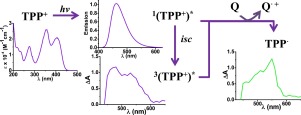当前位置:
X-MOL 学术
›
J. Hazard. Mater.
›
论文详情
Our official English website, www.x-mol.net, welcomes your
feedback! (Note: you will need to create a separate account there.)
Direct Detection of the Triphenylpyrylium-derived Short-lived Intermediates in the Photocatalyzed Degradation of Acetaminophen, Acetamiprid, Caffeine and Carbamazepine
Journal of Hazardous Materials ( IF 12.2 ) Pub Date : 2017-08-30 , DOI: 10.1016/j.jhazmat.2017.08.063 R. Martinez-Haya, J. Gomis, A. Arques, A.M. Amat, M.A. Miranda, M.L. Marin
Journal of Hazardous Materials ( IF 12.2 ) Pub Date : 2017-08-30 , DOI: 10.1016/j.jhazmat.2017.08.063 R. Martinez-Haya, J. Gomis, A. Arques, A.M. Amat, M.A. Miranda, M.L. Marin

|
Advanced oxidation processes are useful methodologies to accomplish abatement of contaminants; however, elucidation of the reaction mechanisms is hampered by the difficult detection of the short-lived primary key species involved in the photocatalytic processes. Nevertheless, herein the combined use of an organic photocatalyst such as triphenylpyrylium (TPP+) and photophysical techniques based on emission and absorption spectroscopy allowed monitoring the photocatalyst-derived short-lived intermediates. This methodology has been applied to the photocatalyzed degradation of different pollutants, such as acetaminophen, acetamiprid, caffeine and carbamazepine. First, photocatalytic degradation of a mixture of the pollutants showed that acetaminophen was the most easily photodegraded, followed by carbamazepine and caffeine, being the abatement of acetamiprid almost negligible. This process was accompanied by mineralization, as demonstrated by trapping of carbon dioxide using barium hydroxide. Then, emission spectroscopy measurements (steady-state and time-resolved fluorescence) allowed demonstrating quenching of the singlet excited state of TPP+. Laser flash photolysis experiments with absorption detection showed that oxidation of contaminants is accompanied by TPP+ reduction, with formation of a pyranyl radical (TPP.), that constituted a fingerprint of the redox nature of the occurring process. The relative amounts of TPP. detected was also correlated with the efficiency of the photodegradation process.
中文翻译:

直接检测对乙酰氨基酚,对乙酰氨基苯甲酸,咖啡因和卡马西平的光催化降解中三苯基吡啶鎓衍生的短寿命中间体
先进的氧化工艺是完成污染物消除的有用方法。然而,由于难以检测到光催化过程中涉及的短寿命的主要关键物质,阻碍了对反应机理的阐明。不过,本文将有机光催化剂(如三苯基吡啶鎓(TPP +)和基于发射光谱和吸收光谱的光物理技术,可以监测光催化剂衍生的短寿命中间体。该方法已用于光催化降解不同污染物,例如对乙酰氨基酚,对乙酰氨基苯甲酸,咖啡因和卡马西平。首先,污染物的混合物的光催化降解显示对乙酰氨基酚是最容易光降解的,其次是卡马西平和咖啡因,对乙酰氨基酚的减少几乎可以忽略不计。该过程伴随有矿化作用,如使用氢氧化钡捕集二氧化碳所证明的。然后,通过发射光谱测量(稳态和时间分辨荧光)可以证明TPP +的单线激发态的猝灭。具有吸收检测功能的激光闪光光解实验表明,污染物的氧化伴随着TPP +还原,并形成了吡喃基自由基(TPP 。),构成了正在发生的过程的氧化还原性质。TPP的相对含量。检测到的光也与光降解过程的效率相关。
更新日期:2017-08-31
中文翻译:

直接检测对乙酰氨基酚,对乙酰氨基苯甲酸,咖啡因和卡马西平的光催化降解中三苯基吡啶鎓衍生的短寿命中间体
先进的氧化工艺是完成污染物消除的有用方法。然而,由于难以检测到光催化过程中涉及的短寿命的主要关键物质,阻碍了对反应机理的阐明。不过,本文将有机光催化剂(如三苯基吡啶鎓(TPP +)和基于发射光谱和吸收光谱的光物理技术,可以监测光催化剂衍生的短寿命中间体。该方法已用于光催化降解不同污染物,例如对乙酰氨基酚,对乙酰氨基苯甲酸,咖啡因和卡马西平。首先,污染物的混合物的光催化降解显示对乙酰氨基酚是最容易光降解的,其次是卡马西平和咖啡因,对乙酰氨基酚的减少几乎可以忽略不计。该过程伴随有矿化作用,如使用氢氧化钡捕集二氧化碳所证明的。然后,通过发射光谱测量(稳态和时间分辨荧光)可以证明TPP +的单线激发态的猝灭。具有吸收检测功能的激光闪光光解实验表明,污染物的氧化伴随着TPP +还原,并形成了吡喃基自由基(TPP 。),构成了正在发生的过程的氧化还原性质。TPP的相对含量。检测到的光也与光降解过程的效率相关。











































 京公网安备 11010802027423号
京公网安备 11010802027423号